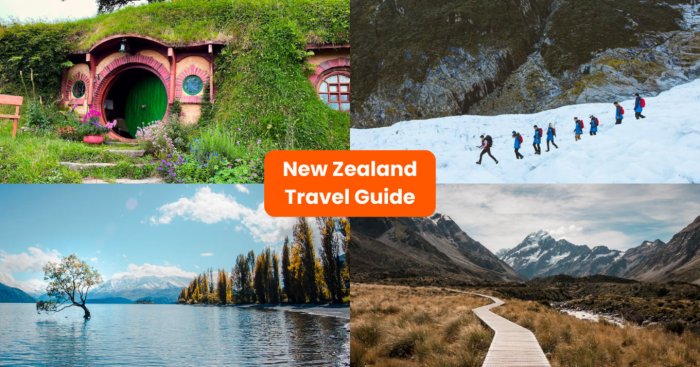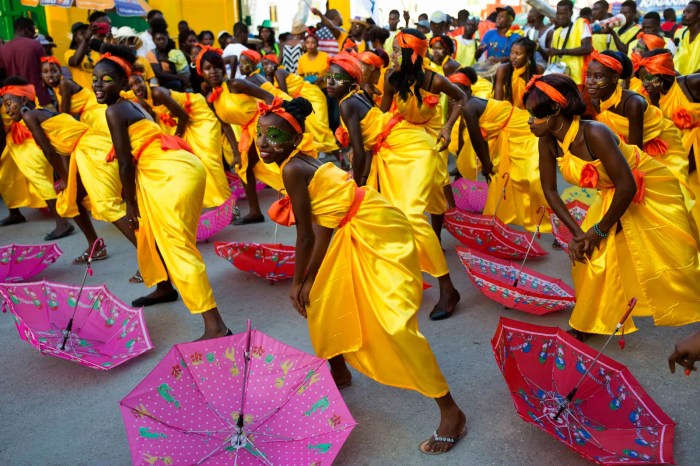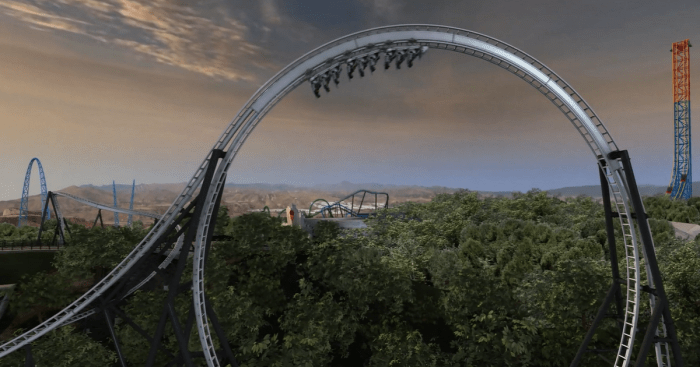New Zealand travel guide sets the stage for an unforgettable journey through this stunning land. From vibrant cities to breathtaking landscapes, this guide unveils the magic of New Zealand, catering to every traveler’s taste. Whether you’re an adventure seeker, a family on a vacation, or a couple seeking romance, you’ll find the perfect experience within these pages. Discover the key reasons why millions choose New Zealand, from its awe-inspiring scenery to its welcoming people.
This guide provides a comprehensive overview of New Zealand’s must-see destinations, highlighting their unique attractions and activities. We’ll explore the North and South Islands, revealing the diverse experiences each offers. You’ll discover everything from the iconic Sky Tower in Auckland to the thrilling adventures of Queenstown, and the geothermal wonders of Rotorua. We’ll dive deep into the activities, from hiking to bungy jumping, and cultural encounters with Maori heritage.
We’ll also explore the diverse accommodation options, from budget-friendly hostels to luxurious lodges, and delve into the delicious culinary scene, showcasing the freshest local produce. Get ready to embark on your New Zealand adventure!
Introduction to New Zealand Travel
New Zealand, a land of breathtaking landscapes, vibrant culture, and thrilling adventures, beckons travelers from around the globe. Its unique blend of rugged mountains, pristine beaches, and lush rainforests creates an unparalleled travel experience. This guide explores the diverse appeal of New Zealand, highlighting the different types of travelers who find it irresistible, and the reasons that draw them to this spectacular island nation.New Zealand’s allure extends far beyond its stunning scenery.
The country’s welcoming atmosphere, friendly locals, and abundance of outdoor activities make it a perfect destination for a wide range of travellers. Whether you’re seeking adrenaline-pumping adventures, relaxing beach getaways, or cultural immersion, New Zealand has something to offer everyone.
Types of Travelers Attracted to New Zealand
New Zealand’s appeal transcends demographics. A diverse range of travelers find the country’s unique blend of natural beauty and vibrant culture irresistible. Families are drawn to the child-friendly activities and educational opportunities. Couples appreciate the romantic settings and opportunities for shared adventures. Adventure seekers revel in the challenging hikes, thrilling whitewater rafting, and exhilarating bungy jumps.
Nature enthusiasts are captivated by the stunning landscapes and unique wildlife. History buffs can delve into the country’s rich Māori heritage. Solo travelers find a welcoming atmosphere and the freedom to explore at their own pace.
Key Reasons for Choosing New Zealand
New Zealand’s appeal stems from several key factors that resonate with travelers worldwide. The unparalleled natural beauty is a primary draw, with landscapes ranging from towering mountains to pristine beaches, lush rainforests, and glaciers. The country’s active outdoor lifestyle, including hiking, kayaking, and skiing, offers numerous opportunities for adventure and exploration. New Zealand’s friendly and welcoming atmosphere is a significant contributor to the overall travel experience.
Planning a trip to New Zealand? I’ve got some awesome tips for exploring the stunning landscapes. While you’re researching destinations, don’t forget to check out the vibrant culture of New Orleans, LA. For a fantastic guide on exploring the French Quarter and beyond, visit new orleans la travel. Ultimately, though, a New Zealand travel guide is still the best resource for your trip down under!
The strong emphasis on sustainability and environmental responsibility further enhances its appeal for eco-conscious travelers.
Different Experiences Offered
New Zealand caters to diverse interests and preferences. The country offers a range of activities that cater to families, couples, adventure enthusiasts, and nature lovers. Families can enjoy kid-friendly attractions, such as national parks with walking trails and wildlife encounters. Couples can discover romantic hideaways, from scenic coastal drives to luxurious lodges. Adventure seekers can participate in activities like whitewater rafting, bungy jumping, and canyon swinging.
Nature lovers can immerse themselves in the stunning landscapes through hiking, kayaking, and wildlife spotting.
Experiences for Different Interests
The diverse landscapes and activities in New Zealand cater to a broad range of interests. History enthusiasts can explore museums and historical sites, learning about the Māori culture and the nation’s past. Foodies can indulge in local cuisine, sampling fresh seafood, and farm-to-table dishes. Culture vultures can participate in cultural events, learning about the local traditions and meeting the friendly locals.
Relaxation seekers can find tranquil spots along the coastline, or in the serene landscapes. New Zealand offers something for everyone, from exhilarating adventures to peaceful retreats.
Must-See Destinations: New Zealand Travel Guide
New Zealand’s stunning landscapes and diverse experiences make it a bucket-list destination for many travelers. From the vibrant cities to the breathtaking natural wonders, there’s something to captivate every visitor. This section highlights the must-see destinations, outlining their unique characteristics and contrasting the North and South Islands’ offerings.
Iconic Destinations
New Zealand boasts a plethora of iconic destinations, each with its own special allure. These destinations cater to a range of interests, from adventure seekers to nature lovers and city explorers. The following list showcases some of the most popular and unforgettable spots.
- Auckland: A vibrant metropolis nestled on the North Island, Auckland offers a perfect blend of city life and natural beauty. Its iconic Sky Tower provides panoramic views, while Waiheke Island, a short ferry ride away, beckons with its picturesque vineyards and stunning beaches.
- Queenstown: Renowned as an adventure capital, Queenstown on the South Island is a hub for adrenaline junkies. The stunning Fiordland National Park and Milford Sound, with their dramatic landscapes, provide breathtaking natural beauty. The town itself buzzes with excitement, offering various adventure activities.
- Rotorua: Situated in the North Island, Rotorua is a gateway to geothermal wonders and Maori culture. Te Puia, a renowned Maori cultural park, showcases traditional practices and stunning geothermal features. The area’s natural hot springs and Polynesian Spa experiences provide relaxation and rejuvenation.
North Island vs. South Island
The North and South Islands of New Zealand offer contrasting experiences. The North Island is known for its volcanic landscapes, geothermal activity, and thriving cities. The South Island, on the other hand, is renowned for its towering mountains, dramatic fjords, and breathtaking hiking trails. While both islands offer stunning scenery and diverse experiences, they cater to different interests.
Destination Details
The table below summarizes key attractions, activities, and accommodations for each destination. This information provides a quick overview of what to expect and helps plan your trip.
Activities and Experiences
New Zealand’s stunning landscapes and vibrant culture offer a plethora of activities for every type of traveler. From thrilling adventures to serene nature walks, and immersive cultural encounters, there’s something to captivate everyone. Prepare to be amazed by the diverse experiences this remarkable nation provides.New Zealand’s appeal lies in its ability to seamlessly blend adrenaline-pumping activities with opportunities for deep connection with nature and its indigenous people.
Whether you seek the thrill of bungy jumping or the tranquility of a remote hiking trail, New Zealand delivers an unforgettable journey.
Hiking Adventures
New Zealand boasts some of the most breathtaking hiking trails in the world. From short, easy walks perfect for families to challenging multi-day treks for seasoned hikers, the options are limitless. The varied terrains, from lush rainforests to alpine meadows, offer stunning vistas at every turn. Popular destinations include the Tongariro Alpine Crossing and the Kepler Track, renowned for their spectacular scenery.
The best time to hike is generally during the spring and autumn seasons, when the weather is pleasant and the trails are less crowded.
Thrilling Adventures
New Zealand is synonymous with adventure activities. Bungy jumping, white-water rafting, and jet boating are just a few of the exhilarating experiences available. These activities provide an unparalleled opportunity to push your limits and experience the raw power of nature. For example, the Kawarau Bridge in Queenstown offers iconic bungy jumping, while the Shotover River is a popular choice for white-water rafting.
My New Zealand travel guide is almost ready! I’ve been researching the best spots for breathtaking scenery, and I’m also keen to find the perfect comfy shoes for all those hikes. Speaking of comfy, I just stumbled across this article on best editor loved white sneakers , which looks like it’ll be perfect for tackling the trails and exploring everything New Zealand has to offer.
Hopefully, these sneakers will be my ultimate companions for all my adventures in this beautiful country!
The best time for adventure activities generally aligns with the shoulder seasons, avoiding the peak summer heat and winter’s harsh conditions.
Whale Watching
New Zealand’s waters teem with marine life, making it a prime destination for whale watching tours. Sightings of humpback whales, orcas, and dolphins are common, offering a unique and unforgettable experience. The best time to witness these magnificent creatures is generally during the summer months (December to March), when they are most active in the waters.
Cultural Immersion
Immerse yourself in the rich Maori culture through guided tours, traditional performances, and interactions with local communities. Understanding the Maori people’s connection to the land is crucial for a truly immersive experience. Learning about their history, traditions, and values provides a deeper appreciation for the country’s heritage. The best time to visit for cultural experiences is generally year-round, as cultural events and performances occur throughout the year.
Nature’s Embrace
New Zealand’s unparalleled natural beauty is a significant draw for visitors. From towering mountains and glaciers to pristine beaches and lush forests, the landscape offers a sense of tranquility and awe. Experiencing nature’s grandeur is an essential part of any New Zealand adventure. The diverse landscapes and pristine environments invite contemplation and appreciation of the planet’s beauty.
Comparing Popular Activities
| Activity | Description | Suitable for | Difficulty |
|---|---|---|---|
| Hiking | Exploring New Zealand’s natural beauty on foot | Nature lovers, Families | Beginner to Expert |
| Bungy Jumping | Thrilling jump from a high point | Adventure seekers | Moderate to Extreme |
| Whale Watching | Observe whales in their natural habitat | Nature lovers, Families | Easy |
Accommodation Options
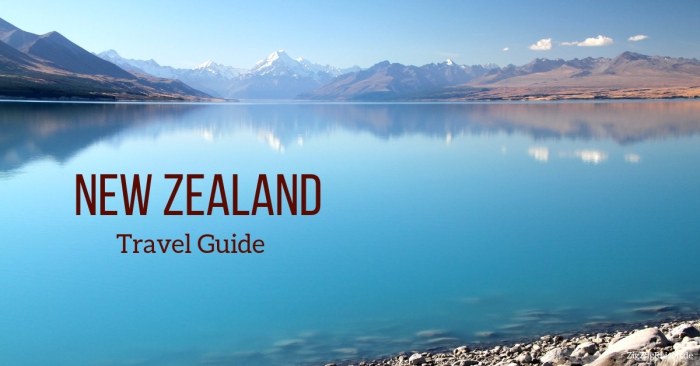
New Zealand offers a diverse range of accommodation options to suit every traveler’s needs and budget, from luxurious hotels to budget-friendly hostels. Choosing the right place to stay is crucial for a comfortable and enjoyable trip, and understanding the nuances of each type will help you make the best choice. This section will delve into the various accommodation options available, their price ranges, and how to find the perfect fit for your trip.Finding the right accommodation is an important part of planning your trip.
Factors like budget, travel style, and desired experiences influence your choice. Consider whether you’re traveling solo, with a partner, or with family, and what kind of atmosphere you’re looking for. The variety of options in New Zealand ensures there’s something for everyone, whether you prefer a cozy guesthouse or a bustling hotel.
Hotel Accommodation
Hotels provide a wide range of amenities and services, catering to various needs. These include comfortable rooms, complimentary breakfast, swimming pools, spas, and often meeting rooms. They typically offer a higher level of service and are suitable for families, couples, and business travelers seeking a convenient and luxurious stay. Expect to pay a higher price for these accommodations compared to other options, but the amenities and convenience often justify the cost.
High-end hotels in popular tourist destinations often require advance bookings.
Hostel Accommodation
Hostels offer a vibrant and social atmosphere, particularly popular among backpackers and solo travelers. These budget-friendly accommodations often feature shared dormitories and private rooms. Hostels often have common areas for socializing, organized activities, and meeting other travelers. Expect to find a more relaxed and social environment compared to hotels. They are ideal for those seeking budget-friendly options and opportunities to connect with other travelers.
Guesthouse Accommodation
Guesthouses provide a more intimate and personalized experience. They often feature a homey atmosphere and a warm welcome. Guesthouses typically offer a range of private rooms and are a good alternative to hotels. Their smaller size and focus on personalized service can provide a unique experience compared to larger hotels or hostels. Guesthouses are often found in smaller towns and offer a local feel.
Airbnb Accommodation
Airbnb provides a wide range of unique accommodation options, from cozy apartments to charming farm stays. This option allows travelers to experience local culture and enjoy unique settings. The price range varies depending on the property and location, and can be competitive with guesthouses and hotels, especially in popular tourist areas. Airbnb stays offer a more personalized and local experience, often providing a sense of community.
Booking in Advance
Booking accommodations in advance, particularly during peak season, is crucial for securing your desired type of stay. New Zealand experiences significant tourist influx during summer months, and popular destinations often book up quickly. Booking early allows you to compare options, secure the best rates, and avoid disappointment. Websites and apps dedicated to travel booking can help you efficiently search and compare available accommodations.
Planning a New Zealand adventure? I’ve been researching family-friendly ski resorts, and stumbled upon some amazing options for hotels and resorts. Finding the perfect mountain ski resort for your family can be tough, but luckily, there’s a great resource for exploring the best family friendly ski resorts in New Zealand, hotels resorts mountain ski resorts best family friendly ski.
This will help narrow down your search and ensure you find a place that’s perfect for everyone. I’m still putting together my New Zealand travel guide, so stay tuned for more tips!
Comparison of Accommodation Types
Food and Drink
New Zealand’s culinary scene is a vibrant tapestry woven from fresh, local ingredients and global influences. The nation’s commitment to sustainable practices shines through in its farm-to-table approach, resulting in a delicious and unique dining experience. From the hearty flavors of traditional dishes to the innovative creations of modern restaurants, there’s something to satisfy every palate.New Zealand cuisine embraces the bounty of its land and sea.
The country’s diverse landscapes, from rolling hills to rugged coastlines, support a wide array of produce, creating an abundance of fresh, seasonal ingredients. This emphasis on local produce translates into dishes that are both flavorful and environmentally conscious. The use of these fresh ingredients is a cornerstone of the country’s culinary identity.
Popular Restaurants and Cafes
New Zealand boasts a wide array of restaurants and cafes, catering to a range of tastes and budgets. From bustling city centers to charming coastal towns, you’ll find a variety of options to suit your needs. Some popular choices include:
- Auckland: The city offers a diverse culinary scene, with everything from Michelin-starred restaurants to casual cafes serving up delicious breakfasts and lunches. Examples include The French Cafe and The Flying Pig.
- Wellington: Wellington’s vibrant cafe culture and diverse restaurants provide a dynamic culinary experience. Notable establishments include Circa and The Sugar Club.
- Christchurch: The city features a range of restaurants and cafes reflecting its modern and progressive culinary scene. Examples include The Old Spaghetti Factory and The Bean Counter.
- Queenstown: This adventure town caters to both local and international tastes with various restaurants serving up everything from classic pub fare to gourmet meals. Notable choices include The Flying Saucer and The Queenstown Club.
Must-Try Food and Drink Experiences
New Zealand’s food and drink scene offers a variety of unique experiences. From indulging in a classic fish and chips meal to sampling regional delicacies, you’ll find experiences that suit your interests.
- Wine Tasting: New Zealand is renowned for its high-quality wines, particularly Sauvignon Blanc. Many wineries offer tours and tastings, allowing you to experience the winemaking process firsthand.
- Farm-to-Table Dining: Many restaurants emphasize the use of fresh, local produce in their dishes. This provides an opportunity to savor the flavors of the region while supporting local farmers.
- Seafood Delights: New Zealand’s coastal regions provide an abundance of fresh seafood. Many restaurants offer delectable dishes featuring local catches.
- Street Food Adventures: Cities and towns across New Zealand often feature vibrant street food markets and stalls. These provide a chance to sample a variety of local flavors at affordable prices.
Fresh, Local Produce in New Zealand Cuisine
New Zealand’s cuisine is deeply rooted in the use of fresh, seasonal produce. This translates to dishes that are flavorful, vibrant, and environmentally responsible. The emphasis on fresh ingredients highlights the country’s commitment to sustainable practices.
- Seasonal Availability: New Zealand’s varied climate allows for a wide range of produce to be available throughout the year. This seasonal availability influences the ingredients used in many dishes.
- High-Quality Produce: The country’s commitment to quality agriculture results in high-quality ingredients, which enhance the taste of the dishes.
- Local Sourcing: The use of locally sourced ingredients supports local farmers and contributes to the sustainability of the food system.
Must-Try Foods and Drinks
This table highlights some of the must-try food and drink experiences in New Zealand.
| Food/Drink | Description | Region |
|---|---|---|
| Fish and Chips | A classic New Zealand dish featuring fresh fish and crispy chips. | Nationwide |
| Lamb | A popular meat in New Zealand cuisine, often cooked to perfection. | Nationwide |
| Paua | A type of shellfish, often served as a delicious appetizer or main course. | Coastal Regions |
| Kiwi Fruit | A unique New Zealand fruit, widely available and a delicious snack or addition to various dishes. | Nationwide |
Practical Information
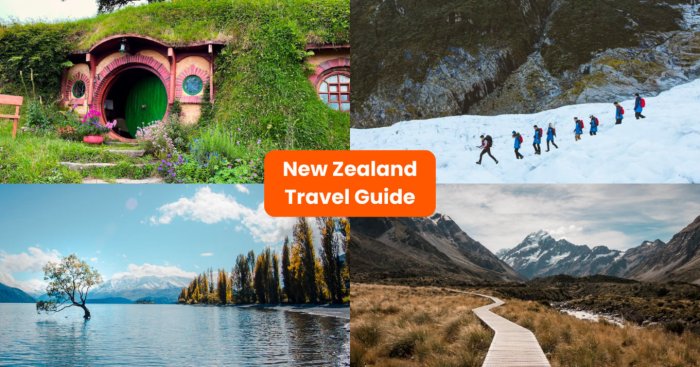
New Zealand’s stunning landscapes and vibrant culture are undoubtedly worth experiencing, but a little preparation goes a long way in ensuring a smooth and enjoyable trip. Understanding the practicalities, from essential documents to local customs, will enhance your overall adventure. This section provides vital information to help you navigate your journey effortlessly.Navigating New Zealand’s travel requirements and local customs is essential for a positive experience.
This section details the necessary steps to make your trip as smooth as possible, covering travel documents, currency, transportation, safety, and etiquette.
Essential Travel Documents and Visa Requirements
New Zealand welcomes visitors from many countries, but visa requirements can vary. It’s crucial to check the specific visa requirements for your nationality well in advance of your trip. The official New Zealand government website provides the most up-to-date and accurate information on visa policies. Ensure all necessary documents, such as passports with sufficient validity periods, are in order and carry copies of these documents.
Knowing the requirements beforehand avoids potential delays or problems at the border.
Currency Exchange and Local Payment Methods
New Zealand’s currency is the New Zealand dollar (NZD). While you can exchange currency at airports and banks, it’s often more advantageous to exchange currency before your trip or use your credit or debit cards widely accepted in most establishments. Many businesses also accept international credit and debit cards. Be aware of potential transaction fees associated with using international cards.
Transportation Options
New Zealand offers a variety of transportation options to suit different needs and budgets. Flights are convenient for long distances, connecting major cities. Buses are a cost-effective way to travel between towns and cities, particularly for those on a budget. Train travel offers scenic routes, especially in the South Island. Renting a car allows for flexibility in exploring at your own pace, but remember to obtain international driving permits if needed.
Public transport is efficient and well-maintained in major cities, making it a convenient option for navigating urban areas.
Safety Precautions for Travelers
New Zealand is generally a safe country for tourists. However, basic safety precautions are always advisable. Be aware of your surroundings, especially in crowded areas. Keep valuables secure and report any suspicious activity to the authorities. If you are participating in outdoor activities, be sure to take appropriate safety measures, such as checking the weather forecast and having appropriate gear.
Adhering to these precautions ensures a worry-free experience.
Important Local Customs and Etiquette, New zealand travel guide
New Zealanders are generally friendly and welcoming, but understanding some basic local customs can enhance your interactions. Respect for Maori culture is essential. Learning a few basic Maori phrases demonstrates respect for the indigenous people. Be mindful of the environment and dispose of waste responsibly. Maintaining a respectful tone and manner is key to a positive interaction.
These small considerations make a big difference in fostering positive relationships with the local community.
Essential Travel Tips for New Zealand:
- Pack for all types of weather.
- Book accommodations and tours in advance, especially during peak season.
- Learn a few basic Maori phrases.
- Be respectful of the environment.
Ultimate Conclusion
This New Zealand travel guide provides a concise yet comprehensive exploration of this extraordinary nation. From iconic destinations to unforgettable activities and experiences, you’ll gain a deeper understanding of what makes New Zealand so special. Whether you’re planning your trip or simply dreaming of a New Zealand adventure, this guide serves as a valuable resource to help you make the most of your visit.
From the rugged beauty of the mountains to the warm hospitality of its people, New Zealand awaits your exploration. Pack your bags and prepare for an amazing journey.
